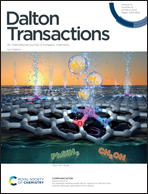Changes in ligand coordination mode induce bimetallic C–C coupling pathways†
Abstract
Carbon–carbon coupling is one of the most powerful tools in the organic synthesis arsenal. Known methodologies primarily exploit monometallic Pd0/PdII catalytic mechanisms to give new C–C bonds. Bimetallic C–C coupling mechanisms that involve a PdI/PdII redox cycle, remain underexplored. Thus, a detailed mechnaistic understanding is imperative for the development of new bimetallic catalysts. Previously, a PdII–Me dimer (1) supported by L1, which has phosphine and 1-azaallyl donor groups, underwent reductive elimination to give ethane, a PdI dimer, a PdII monometallic complex, and Pd black. Herein, a comprehensive experimental and computational study of the reactivity of 1 is presented, which reveals that the versatile coordination chemistry of L1 promotes bimetallic C–C bond formation. The phosphine 1-azaallyl ligand adopts various bridging modes to maintain the bimetallic structure throughout the C–C bond forming mechanism, which involves intramolecular methyl transfer and 1,1-reductive elimination from one of the palladium atoms. The minor byproduct, methane, likely forms through a monometallic intermediate that is sensitive to solvent C–H activation. Overall, the capacity of L1 to adopt different coordination modes promotes the bimetallic C–C coupling channel through pathways that are unattainable with statically-coordinated ligands.



 Please wait while we load your content...
Please wait while we load your content...